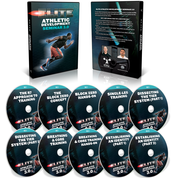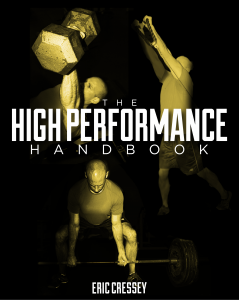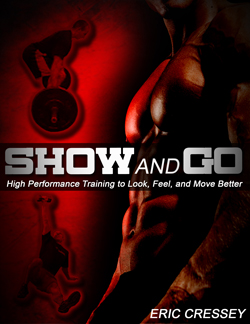Today’s guest post comes from Mike Robertson on the release of Elite Athletic Development 3.0
3 Common Upper Extremity Mistakes
When it comes to training, I’ve made darn near every mistake in the book.
I’ve given the wrong cues.
I’ve written crappy programs.
And sometimes I’ve been guilty of flat-out overcoaching an athlete.
So it only makes sense that I’ve made mistakes when it comes to training the upper extremities of my athletes.
As a coach that’s worked with numerous baseball and volleyball players in the past, I’ve tried to learn as much as possible to keep my athletes healthy.
Here are three mistakes I’ve made, and how I’ve improved upon them today.
Mistake #1 – Poor Core Control
My first coaching gig was as an assistant strength and conditioning coach at Ball State University.
I was working with our volleyball players, and many of them had back issues.
Looking back, this isn’t surprising.
When you have a really tall athlete with long appendages, it’s asking a lot of the core to control those limbs!
So when I trained these girls, I threw every movement-based core exercise at them.
Whether it was crunches, sit-ups, side bends or back extensions, anything I could do to get their core “stronger” was a win in my book.
Knowing what we now know, it’s easy to see the errors in my ways.
But I was only looking at how the core influenced the back – not how the core could influence the shoulder as well.
The first step in helping my overhead athletes is giving them sagittal plane core control.
I’m a big fan of supine core work early-on, especially with tall athletes.
First and foremost, I want them to feel their abs working. This is something that’s very undervalued these days.
Furthermore, when you perform a basic exercise like a 3-month PNF or dead bug, it’s very challenging on the core because that short core has to control those long limbs!
Prone variations work great as well, but we’ll talk more about about the value of reaching later on.
The last piece of the sagittal puzzle is building abs while simultaneously shutting off the lats.
Too often, when our overhead athletes go overhead, they extend their lumbar spine to stabilize.
My goal is to teach them to go overhead using pure shoulder motion, versus lumbar spine extension.
Once you’ve got a serious set of sagittal plane abs, you can then move to the frontal and transverse plane.
So let’s talk about that…
Mistake #2 – Failing to Train Integrated Rotation
When I first started, I thought all rotation was good rotation.
It didn’t matter if it was coming from the hips, lumbar spine or thoracic spine – if they were rotating, it was good!
Nowadays, I’m focused on not only where they rotate, but also how the control rotation.
If we look at the kinetic chain, here’s how I break things down:
- The hips need to be able to rotate, but also demonstrate stability and control.
- I want tri-planar core stability.
- And I want the t-spine (and really, the thorax) to rotate effectively.
Hip rotation makes sense, as it’s a ball-and-socket joint. If the pelvis is positioned well, it allows those hip joints to do their thing.
The core is critical as well. I talked about this extensively before (https://robertsontrainingsystems.com/blog/alternating-function/) but in a well moving athlete, tri-planar core stability allows the hips and thorax to express their natural mobility
For overhead athletes, the most critical element of this is contralateral ab control.
If you want to throw a baseball with your right hand, you need left ab/core control to anchor your rib cage. Once you’ve got that left rib cage locked down, the thorax can rotate to the right.
And if you don’t have that, you’ll be forced to compensate through your lumbar spine.
Last but not least, we have the thorax. For years we’ve talked a lot about the thoracic spine, but the thorax is probably a better term.
We want and need our thorax to move well to set upper extremity position. If you can’t rotate the thorax, then the shoulder will be forced to compensate.
Mistake #3 – Not Performing Enough Reaching
The last piece of the puzzle is a lack of reaching exericses.
To be frank, for years I didn’t see the purpose of reaching exercises like push-ups in a program.
After all, couldn’t you just bench, row and chin if you wanted to get strong?
However, reaching does some really powerful things for our body.
First off, reaching trains the serratus anterior, which we know is critical for upward rotation of the scapula.
But perhaps more importantly, the serratus anterior can pull the rib cage back.
In many athletes, I see a flat or extended thoracic spine. The natural kyphosis that should be there is not.
With a flat thoracic spine, you lose stability at the scapula.
And you know where this ends up – an unstable scapula leads to an unstable shoulder!
Reaching exercises, on the other hand, help restore that natural kyphosis to the scapula(e), and improve stability and control throughout the upper extremity.
As such, all of my overhead athletes have a healthy dose of reaching exercises in their program these days.
Summary
As you can see, I’ve made more than my fair share of mistakes when it comes to upper extremity training in the past.
However, hopefully by learning from my mistakes, you can help your patients, clients and athletes get better outcomes going forward.
Mike Robertson and Joe Kenn just released their Elite Athletic Development 3.0 Seminar DVD set. It is on sale through 7/22/16 at midnight for $100 off. I would consider it a valuable resource for anyone who treats and trains overhead patients / athletes. I do not recommend it if you view clients’ movement patterns as uni-planar. However, if you do view and treat from a multi-planar and multi-system approach, you need to check it out here.




Follow Joe